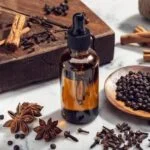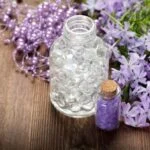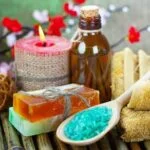Aromatherapy massage is a unique and transformative experience that combines the therapeutic benefits of essential oils with the healing power of touch. In this introductory section, we will delve into the fundamental aspects of aromatherapy massage, providing you with a comprehensive understanding of what it entails and its origins.
To begin, let’s clarify the two main components of aromatherapy massage. Aromatherapy is the practice of using essential oils derived from plants to promote physical and emotional well-being. These concentrated oils are extracted from various parts of plants and possess distinct aromatic properties that can affect our mood, emotions, and overall health.
On the other hand, massage involves applying pressure and manipulating soft tissues in the body to alleviate muscular tension, reduce stress, and enhance relaxation. It is a highly effective form of therapy that has been practiced for centuries across different cultures around the world.
When these two practices merge, we have an aromatherapy massage. This specialized massage technique incorporates the use of specific essential oils to enhance the therapeutic benefits of traditional massage. The combination creates a holistic experience that not only relaxes the body but also rejuvenates the mind and spirit.
The history and origins of aromatherapy massage can be traced back to ancient civilizations such as Egypt, China, and India. These cultures recognized the healing properties of aromatic plants and developed techniques to incorporate their essences in massages.
By understanding these basics, you’ll gain a deeper appreciation for the art and science behind aromatherapy massage. Now let us explore further into essential oils used in this form of therapy in our next section.
Understanding Essential Oils in Aromatherapy Massage
Essential oils play a crucial role in aromatherapy massage, as they are the key ingredient that provides all the therapeutic benefits. These oils are highly concentrated plant extracts that have been used for centuries for their medicinal properties. When incorporated into a massage, essential oils not only enhance relaxation but also provide multiple health benefits.
In aromatherapy massage, essential oils are typically diluted with carrier oils before they are applied to the skin. This dilution helps ensure safety and prevents skin irritation or allergic reactions. Carrier oils, such as jojoba, almond, or coconut oil, help to evenly distribute the essential oils on the skin and allow for better absorption.
There is a wide range of essential oils used in aromatherapy massages, each with its own unique properties and benefits. Some popular essential oils include lavender, known for its calming effects; eucalyptus, which can promote respiratory health; peppermint, great for relieving muscle tension; and tea tree oil, known for its antiseptic properties.
During an aromatherapy massage session, the massage therapist will carefully select and blend specific essential oils based on the client’s needs and preferences. The therapist may use different essential oil combinations depending on whether the goal is relaxation, stress relief, pain management, or other specific concerns.
Health Benefits of Aromatherapy Massage
Aromatherapy massage offers a wide range of health benefits that can improve both physical and mental well-being. Incorporating essential oils into a massage session enhances the therapeutic effects of the massage, making it a popular choice for those seeking holistic healing. Here are some key health benefits of aromatherapy massage:
Relief from stress and anxiety
One of the primary benefits of aromatherapy massage is its ability to promote relaxation and reduce stress. The inhalation of essential oils triggers the release of certain chemicals in the brain, such as serotonin and endorphins, which help to uplift mood and induce a sense of calmness. Aromatherapy massage also leads to a decrease in cortisol levels, the hormone associated with stress. Regular sessions can have long-lasting effects on reducing anxiety levels.
Reduce muscle tension and pain
The combination of aromatherapy and massage can effectively alleviate muscle tension and pain. Essential oils like lavender, peppermint, and eucalyptus have analgesic properties that can help soothe sore muscles and ease discomfort. Massaging these oils onto affected areas helps increase blood circulation and reduce inflammation. Additionally, the physical manipulation of the muscles during a massage also aids in releasing built-up tension.
Improvement in sleep quality and insomnia
Aromatherapy massage has been found to improve sleep quality by promoting relaxation and reducing insomnia symptoms. Essential oils like chamomile, ylang-ylang, or sandalwood are known for their sedative properties when inhaled or applied topically. The combination of these calming scents along with gentle massage movements can promote deep relaxation, relieve anxiety-related sleep disturbances, and establish healthier sleep patterns.
Boosting mood and overall well-being
The pleasant aromas of essential oils used in aromatherapy massage have a positive impact on emotions and can boost mood. Essential oils like citrus scents (such as lemon or orange) have energizing effects, whereas floral scents (such as rose or jasmine) are known for their mood-enhancing and soothing qualities. The release of endorphins during massage further contributes to an overall sense of well-being, leaving individuals feeling relaxed, uplifted, and rejuvenated.
Support for the immune system
Regular aromatherapy massage sessions can provide support to the immune system. Certain essential oils possess antimicrobial and antiviral properties that help fight off pathogens and harmful bacteria. Oils such as tea tree, eucalyptus, or thyme are commonly used in aromatherapy massage to bolster the immune system’s natural defenses. The gentle stimulation of lymphatic flow during the massage also aids in removing toxins from the body, further supporting immune function.
Easing digestion issues
Aromatherapy massage can also benefit those experiencing digestive problems. Essential oils like ginger or peppermint have been traditionally used to alleviate symptoms such as bloating, indigestion, or nausea. When applied topically during a massage, these oils can stimulate digestion, reduce inflammation in the gut, and calm an upset stomach. Aromatherapy massage techniques targeted at the abdominal area can provide additional relief for digestive discomfort.
Incorporating aromatherapy into a massage session amplifies its therapeutic effects and offers numerous health benefits. Whether you’re seeking relaxation, relief from pain or anxiety, improved sleep quality, enhanced mood, stronger immunity or relief from digestion issues – aromatherapy massage has something to offer for everyone’s holistic well-being.
Techniques and Movements in Aromatherapy Massage
In an aromatherapy massage, the massage therapist utilizes various techniques and movements to provide a relaxing and therapeutic experience for the client. The combination of these techniques with the inhalation and absorption of essential oils creates a holistic approach to wellness.
The role of the massage therapist in an aromatherapy massage goes beyond just applying pressure to the body. They aim to create a safe and nurturing environment for their clients, taking into consideration their specific needs and preferences. By using different techniques, they can address specific concerns such as muscle tension, stress, or pain.
Some common massage techniques used in aromatherapy massages include:
- Effleurage: This technique involves using long, sweeping strokes with varying pressures on the body’s surface. It helps to relax muscles, improve blood circulation, and enhance lymphatic drainage.
- Petrissage: Petrissage involves kneading, squeezing, or rolling motions that target deeper muscle layers. This technique helps relieve muscle tension and improve flexibility.
- Friction: Friction is a technique where deep pressure is applied using circular or transverse movements. It can help break down scar tissue or adhesions in muscles, providing pain relief and increased range of motion.
- Tapotement: Also known as percussion or tapping, tapotement involves rhythmic movements such as cupping, hacking, or pounding on the body. It promotes relaxation and stimulates nerve endings.
During an aromatherapy massage session, the therapist incorporates essential oils into their practice to enhance the benefits of the treatment. They may dilute essential oils in carrier oils before applying them to the client’s skin or diffuse them into the air for inhalation purposes. The combination of these techniques and essential oils contributes to a deeply relaxing experience that promotes overall well-being.
Table: Popular Essential Oils Used in Aromatherapy Massages and Their Benefits
| Essential Oil | Benefits |
|---|---|
| Lavender | Promotes relaxation, relieves stress and anxiety, improves sleep quality |
| Peppermint | Relieves muscle pain and tension, boosts energy and focus |
| Eucalyptus | Clears congestion, enhances respiratory function, reduces inflammation |
| Lemon | Elevates mood, revitalizes the mind and body, supports digestion |
By understanding and incorporating these techniques and movements into an aromatherapy massage session, individuals can experience the therapeutic benefits of both the massage itself and the essential oils used. It is important to communicate with the massage therapist about individual preferences, concerns, and any specific health conditions to ensure a customized experience that meets your needs.
What to Expect During an Aromatherapy Massage
During an aromatherapy massage, there are several factors that contribute to the overall experience. This section will outline what clients can expect during their aromatherapy massage session, including preparation, ambiance, consultation, and the different types of massage tables and draping techniques used.
Preparation before the Massage
Before an aromatherapy massage session, it is important for both the client and therapist to prepare themselves physically and mentally. Clients should arrive at the session well-rested and hydrated. It is recommended to avoid heavy meals or alcohol prior to the massage to maximize its benefits. The therapist will also prepare by making sure they have all necessary supplies and equipment readily available.
Setting the Ambiance: Lighting, Music, and Scents
Creating a soothing atmosphere is crucial in an aromatherapy massage. Soft lighting or candles can be used to create a relaxing ambiance. Calming music or nature sounds are often played in the background to enhance relaxation. Additionally, aromatic scents from essential oils may be diffused into the air or applied directly on tissues or fabrics in the room to promote relaxation and enhance the overall experience.
The Role of Consultation and Client Preferences
Before beginning the massage, a consultation will typically take place between the client and therapist. This allows the therapist to understand any specific goals or concerns that the client may have. The client may also indicate their preference for certain essential oils or areas of focus during the massage. This consultation ensures that both parties are on the same page regarding expectations and helps tailor the session accordingly.
The Different Types of Massage Tables and Draping Techniques
Aromatherapy massages are typically performed on a padded massage table. The table may be adjustable for comfort and provide additional features such as face cradles or armrests. The type of draping technique used will depend on both client preference and local regulations. Common draping techniques include using a sheet, towel, or blanket to cover specific areas of the body while leaving others exposed. The therapist will ensure that the client feels comfortable and adequately draped throughout the entire session.
Overall, clients can expect a calm and relaxing environment during their aromatherapy massage session. The therapist will take several factors into consideration, such as preparation, ambiance, consultation, and draping techniques, to ensure a pleasant experience for the client. By addressing these aspects, both parties can fully immerse themselves in the therapeutic benefits of aromatherapy massage.
The Importance of Proper Dilution and Safety in Aromatherapy Massage
Proper dilution and safety are crucial aspects of aromatherapy massage to ensure the well-being of the client. Essential oils used in aromatherapy massage are highly concentrated plant extracts, and using them undiluted can lead to skin irritation, sensitization, or even adverse reactions. To prevent these risks, it is essential to understand the importance of dilution and follow industry standards for safe practice.
Why proper dilution of essential oils is crucial:
- Essential oils are potent substances that need to be diluted before applying them to the skin during a massage. Diluting essential oils allows them to be safely absorbed by the body without causing harm or irritation.
- Proper dilution also helps maximize the therapeutic benefits of essential oils. When diluted correctly, the oils can penetrate into the bloodstream, promoting relaxation, reducing inflammation, and supporting various body functions.
- The ratio for diluting essential oils varies depending on factors such as the purpose of the massage, sensitivity of the individual, and type of oil being used. Typically, a safe dilution ratio for aromatherapy massage is 2-3% (approximately 10-15 drops per ounce) when using adult-friendly essential oils.
Understanding carrier oils and their role in aromatherapy massage:
- Carrier oils play a vital role in aromatherapy massage by providing a medium for diluting essential oils. These base oils are derived from plants and have their own unique properties that complement the therapeutic effects of essential oils.
- Commonly used carrier oils include jojoba oil, sweet almond oil, coconut oil, grapeseed oil, and avocado oil. Each carrier oil has its own characteristics such as absorption rate, scent profile, and texture.
- When choosing a carrier oil, it is important to consider factors such as skin type, personal preferences, potential allergies or sensitivities, and any specific therapeutic goals.
Ensuring the safety of the client: allergies, sensitivities, and contraindications:
- Prior to an aromatherapy massage session, it is crucial for the therapist to conduct a thorough consultation with the client. This helps identify any existing allergies, sensitivities, or medical conditions that may affect the choice of essential oils and potential contraindications.
- Some individuals may have known allergies or sensitivities to specific plants or essential oils. It is important for the therapist to have this information in order to choose alternative oils that are safe for the client.
- Certain medical conditions or medications may also contraindicate the use of certain essential oils. For example, pregnant women should avoid essential oils such as clary sage and rosemary. It is vital for both massage therapists and clients to be aware of these considerations to ensure a safe and effective aromatherapy massage experience.
Industry standards and best practices for aromatherapy massage safety:
- Aromatherapy massage practitioners should adhere to industry standards and best practices for safety during treatment sessions.
- Certification from reputable organizations like Alliance of International Aromatherapists (AIA) or National Association for Holistic Aromatherapy (NAHA) demonstrates that a practitioner has received appropriate training in safety practices.
- It is also important to ensure that essential oils used in aromatherapy massage are sourced from reputable suppliers who provide detailed information on purity, quality testing, and proper handling guidelines.
By prioritizing proper dilution and following safety protocols in aromatherapy massage, both the practitioner and client can safely enjoy the therapeutic benefits of essential oils while minimizing risks or adverse reactions.
DIY Aromatherapy Massage at Home
Many people enjoy the relaxation and therapeutic benefits of aromatherapy massage, but it is not always feasible or convenient to go to a professional spa or therapist. Fortunately, with a few simple tools and techniques, you can create a soothing ambiance and give yourself an aromatherapy massage in the comfort of your own home.
Creating a Relaxing Ambiance
Before you begin your DIY aromatherapy massage, it is important to set the mood and create a calming environment. Start by choosing a quiet and clutter-free space where you can relax without distractions. Dim the lights or use soft lighting such as candles or twinkle lights to create an intimate and peaceful atmosphere.
Music can also play a significant role in enhancing relaxation during your massage. Select soothing melodies instrumental tracks, nature sounds, or relaxing meditative tunes that help you unwind. Additionally, consider using scents to enhance the therapeutic experience. Aromatherapy diffusers or scented candles can be used to fill the room with pleasant fragrances that complement your chosen essential oils.
Choosing Essential Oils for Self-Massage
When selecting essential oils for your at-home aromatherapy massage, it is important to consider their specific benefits and properties. Here are some popular essential oils and their associated benefits:
- Lavender: Known for its calming effects, lavender oil promotes relaxation, reduces anxiety, relieves stress, and helps improve sleep quality.
- Peppermint: With its cooling sensation and invigorating aroma, peppermint oil is often used to ease headaches, reduce muscle tension, and increase focus.
- Eucalyptus: This oil is commonly used for respiratory support due to its decongestant properties. It can also provide relief from muscle soreness.
- Chamomile: Renowned for its soothing qualities, chamomile oil helps calm the mind and relax the body. It is often used to alleviate stress and promote better sleep.
Remember that essential oils should be diluted with a carrier oil before applying them to the skin during massage. Sweet almond, jojoba, or coconut oil are popular choices for carrier oils in aromatherapy massages.
Step-by-Step Guide to Self-Aromatherapy Massage
Once you have created a serene ambiance and selected your essential oils, follow these steps to give yourself a rejuvenating aromatherapy massage at home:
- Prepare your massage area by laying down a clean towel or mat.
- Dilute 5-10 drops of your chosen essential oil in 1 ounce of carrier oil.
- Warm the oil mixture between your hands before applying it evenly over the desired areas of your body.
- Begin the massage with gentle strokes and gradually increase pressure as needed.
- Use long, flowing motions like effleurage for relaxation and deeper movements such as kneading or petrissage for muscle tension relief.
- Focus on any areas where you feel discomfort or tightness, applying more pressure if necessary.
- Take deep breaths and consciously relax your mind and body throughout the massage.
- After completing the massage, take some time to rest and enjoy the lingering effects of the essential oils.
Performing self-aromatherapy massage regularly can be an excellent way to incorporate self-care into your routine, relieve stress, soothe sore muscles, and promote overall well-being.
| Essential Oil | Benefits |
|---|---|
| Lavender | Promotes relaxation, reduces anxiety, relieves stress, improves sleep quality |
| Peppermint | Eases headaches, reduces muscle tension, increases focus |
| Eucalyptus | Provides respiratory support, relieves muscle soreness |
| Chamomile | Soothes the mind and body, alleviates stress, promotes better sleep |
Frequently Asked Questions About Aromatherapy Massage
Aromatherapy massage is a popular form of therapy that combines the use of essential oils with massage techniques to promote relaxation, healing, and overall well-being. As with any type of treatment, there are often questions and concerns about its effectiveness, safety, and suitability for certain individuals. In this section, we will address some frequently asked questions about aromatherapy massage to provide clarity and guidance for those interested in exploring this practice.
One common question is whether aromatherapy massage can help with specific health conditions. While it is not a substitute for medical treatment, aromatherapy massage has been known to provide relief for various conditions such as stress, anxiety, muscle tension, insomnia, and digestive issues.
The combination of essential oils and massage can have a calming effect on the body and mind, offering temporary relief from symptoms related to these conditions. However, it is always important to consult with a healthcare professional or a qualified aromatherapist before incorporating aromatherapy massage into your wellness routine.
Another question that often arises is how often one should get an aromatherapy massage. The frequency of sessions depends on factors such as individual needs, goals, and availability. Some people may benefit from regular sessions once or twice a week to maintain their well-being or address chronic conditions.
Others may find occasional massages every few weeks or months sufficient for their needs. It is important to listen to your body and give yourself time to rest between sessions so that you can reap the full benefits of each treatment.
Pregnant individuals may wonder if it is safe to receive an aromatherapy massage during pregnancy. Generally speaking, aromatherapy massage can be safe during pregnancy when certain precautions are taken. Some essential oils are considered safe for use during pregnancy while others should be avoided due to their potential effects on hormone levels or uterine contractions.
It is crucial to work with a qualified prenatal massage therapist who has knowledge of essential oil safety during pregnancy. They will be able to select appropriate oils and adjust the massage techniques to ensure a safe and enjoyable experience for both the mother and the baby.
As with any form of therapy, it is important to consider potential risks or side effects. While aromatherapy massage is generally safe when performed by a trained professional, there can be individual sensitivities or allergies to certain essential oils. It is recommended to inform your massage therapist about any known allergies or sensitivities you have before the session begins.
Additionally, individuals with certain medical conditions may have contraindications to aromatherapy massage, such as epilepsy, low blood pressure, or recent surgery. Always consult with your healthcare provider if you have any concerns or specific health conditions before starting aromatherapy massage.
Conclusion
In conclusion, aromatherapy massage combines the therapeutic benefits of both aromatherapy and massage to provide a truly transformative experience. Throughout this article, we have explored the basics of aromatherapy massage, understanding essential oils and their role in this type of massage, as well as the various health benefits associated with it. Additionally, we have delved into the techniques and movements involved in an aromatherapy massage, what to expect during a session, and the importance of proper dilution and safety.
Aromatherapy massages offer a range of benefits for both the body and mind. From relieving stress and anxiety to reducing muscle tension and pain, these massages can greatly improve one’s overall well-being. They can also help boost mood, support immunity, and ease digestion issues. With so many potential benefits, it’s no wonder why more individuals are turning to aromatherapy massage as part of their holistic wellness routine.
If you haven’t yet experienced an aromatherapy massage, we highly encourage you to give it a try. Whether you seek relaxation, relief from physical discomforts, or simply want to immerse yourself in a state of tranquility, this type of massage can help achieve those goals. Remember the importance of self-care in maintaining optimal health, and consider incorporating aromatherapy massage into your wellness regimen.
Frequently Asked Questions
What is the difference between a normal massage and an aromatherapy massage?
Aromatherapy massage is a specialized form of massage that incorporates the use of essential oils to enhance the therapeutic benefits. While a normal massage focuses on manipulating the muscles and relieving tension, an aromatherapy massage not only targets physical discomfort but also aims to promote mental and emotional relaxation.
The use of specific essential oils in aromatherapy massages can help address specific concerns such as stress, anxiety, or insomnia by stimulating the olfactory system and producing various desired effects.
Are aromatherapy massages worth it?
Whether or not aromatherapy massages are worth it depends on individual preferences and needs. For those seeking a holistic approach to their well-being, aromatherapy massages can offer additional benefits beyond just muscular relief. The combination of scent and touch can create a deeply relaxing experience that promotes overall relaxation, rejuvenation, and improved mood.
The use of essential oils in these massages can also provide additional therapeutic effects, such as reducing inflammation or promoting better sleep. However, if someone is not particularly fond of scents or does not believe in the benefits of holistic therapies, they may not find it worth the extra cost.
What are the disadvantages of aromatherapy massage?
While aromatherapy massages have numerous advantages, there are also a few disadvantages to consider. Firstly, some individuals may have allergies or sensitivities to certain essential oils used during a massage session. This could result in skin irritation or respiratory issues for those with particular sensitivities.
Additionally, depending on the therapist’s skill level and expertise with essential oils, there is a risk of improper dilution or application techniques which could potentially cause harm or adverse reactions. Finally, aromatherapy massages tend to be more expensive than regular massages due to the inclusion of essential oils and specialized training required for therapists administering them. Therefore, cost may be a barrier for some who are seeking this type of treatment regularly.

Are you looking for a natural way to improve your health and wellbeing?
If so, aromatherapy may be the answer for you.





